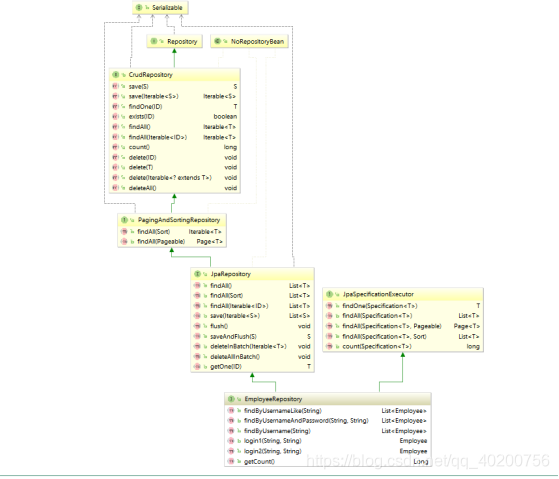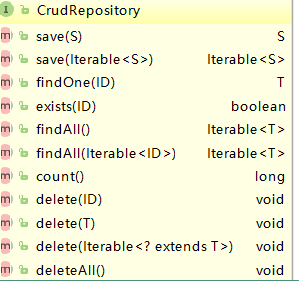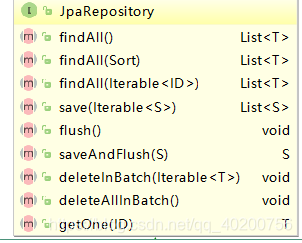Spring SpringMVC JPA项目实战
智能销售系统:项目前期准备
1.配置文件
导包
- utf-8编码
- Jdk1.8
- Spring支持包
spring-core
spring-context
spring-context-support
spring-tx
spring-jdbc
spring-orm
spring-test
- Springmvc
spring-web
spring-webmvc
spring-webmvc
- SpringMVC的json支持包
jackson-core
jackson-annotations
jackson-databind
- hibernate的支持包
hibernate-core
hibernate-entitymanager
- SpringData的支持包
spring-data-jpa
SpringData的扩展展包:jpa-spec(把所有的依懒都去掉)
- 连接池,mysql
commons-dbcp
mysql-connector-java
还有几个支持包,以后要用到在详细解说
<?xml version="1.0" encoding="UTF-8"?>
<project xmlns="http://maven.apache.org/POM/4.0.0" xmlns:xsi="http://www.w3.org/2001/XMLSchema-instance"
xsi:schemaLocation="http://maven.apache.org/POM/4.0.0 http://maven.apache.org/xsd/maven-4.0.0.xsd">
<modelVersion>4.0.0</modelVersion>
<groupId>cn.itsource</groupId>
<artifactId>aisell</artifactId>
<version>1.0-SNAPSHOT</version>
<packaging>war</packaging>
<name>aisell Maven Webapp</name>
<!-- FIXME change it to the project's website -->
<url>http://www.example.com</url>
<properties>
<!-- UTF-8-->
<project.build.sourceEncoding>UTF-8</project.build.sourceEncoding>
<!-- 配置jdk为1.8-->
<maven.compiler.source>1.8</maven.compiler.source>
<maven.compiler.target>1.8</maven.compiler.target>
<!-- 配置几个变量,下面可以直接掉用-->
<org.springframework.version>4.2.5.RELEASE</org.springframework.version>
<org.hibernate.version>4.3.8.Final</org.hibernate.version>
<spring-data-jpa.version>1.9.0.RELEASE</spring-data-jpa.version>
<com.fasterxml.jackson.version>2.5.0</com.fasterxml.jackson.version>
<org.slf4j.version>1.6.1</org.slf4j.version>
</properties>
<dependencies>
<!-- Spring的支持包
-->
<dependency>
<groupId>org.springframework</groupId>
<artifactId>spring-core</artifactId>
<version>${org.springframework.version}</version>
</dependency>
<dependency>
<groupId>org.springframework</groupId>
<artifactId>spring-context</artifactId>
<version>${org.springframework.version}</version>
</dependency>
<dependency>
<groupId>org.springframework</groupId>
<artifactId>spring-context-support</artifactId>
<version>${org.springframework.version}</version>
</dependency>
<dependency>
<groupId>org.springframework</groupId>
<artifactId>spring-tx</artifactId>
<version>${org.springframework.version}</version>
</dependency>
<dependency>
<groupId>org.springframework</groupId>
<artifactId>spring-jdbc</artifactId>
<version>${org.springframework.version}</version>
</dependency>
<dependency>
<groupId>org.springframework</groupId>
<artifactId>spring-orm</artifactId>
<version>${org.springframework.version}</version>
</dependency>
<dependency>
<groupId>org.springframework</groupId>
<artifactId>spring-aop</artifactId>
<version>${org.springframework.version}</version>
</dependency>
<dependency>
<groupId>org.springframework</groupId>
<artifactId>spring-test</artifactId>
<version>${org.springframework.version}</version>
<scope>test</scope>
</dependency>
<!-- 引入web前端的支持 -->
<dependency>
<groupId>org.springframework</groupId>
<artifactId>spring-web</artifactId>
<version>${org.springframework.version}</version>
</dependency>
<dependency>
<groupId>org.springframework</groupId>
<artifactId>spring-webmvc</artifactId>
<version>${org.springframework.version}</version>
</dependency>
<!-- SpringMCV上传需要用到io包-->
<dependency>
<groupId>org.apache.commons</groupId>
<artifactId>commons-io</artifactId>
<version>1.3.2</version>
</dependency>
<!-- 文件上传用到的包 -->
<dependency>
<groupId>commons-fileupload</groupId>
<artifactId>commons-fileupload</artifactId>
<version>1.2.2</version>
</dependency>
<!-- SpringMVC的json支持包-->
<dependency>
<groupId>com.fasterxml.jackson.core</groupId>
<artifactId>jackson-core</artifactId>
<version>${com.fasterxml.jackson.version}</version>
</dependency>
<dependency>
<groupId>com.fasterxml.jackson.core</groupId>
<artifactId>jackson-annotations</artifactId>
<version>${com.fasterxml.jackson.version}</version>
</dependency>
<dependency>
<groupId>com.fasterxml.jackson.core</groupId>
<artifactId>jackson-databind</artifactId>
<version>${com.fasterxml.jackson.version}</version>
</dependency>
<!-- hibernate的支持包 -->
<dependency>
<groupId>org.hibernate</groupId>
<artifactId>hibernate-core</artifactId>
<version>${org.hibernate.version}</version>
</dependency>
<dependency>
<groupId>org.hibernate</groupId>
<artifactId>hibernate-entitymanager</artifactId>
<version>${org.hibernate.version}</version>
</dependency>
<!-- SpringData的支持包 -->
<dependency>
<groupId>org.springframework.data</groupId>
<artifactId>spring-data-jpa</artifactId>
<version>${spring-data-jpa.version}</version>
</dependency>
<!-- SpringData的扩展展包 -->
<dependency>
<groupId>com.github.wenhao</groupId>
<artifactId>jpa-spec</artifactId>
<version>3.1.1</version>
<!-- 把所有的依賴都去掉 -->
<exclusions>
<exclusion>
<groupId>*</groupId>
<artifactId>*</artifactId>
</exclusion>
</exclusions>
</dependency>
<dependency>
<groupId>commons-dbcp</groupId>
<artifactId>commons-dbcp</artifactId>
<version>1.2.2</version>
</dependency>
<dependency>
<groupId>mysql</groupId>
<artifactId>mysql-connector-java</artifactId>
<version>5.1.6</version>
</dependency>
<dependency>
<groupId>org.apache.commons</groupId>
<artifactId>commons-lang3</artifactId>
<version>3.5</version>
</dependency>
<!-- 测试包 -->
<dependency>
<groupId>junit</groupId>
<artifactId>junit</artifactId>
<version>4.12</version>
<scope>test</scope>
</dependency>
<dependency>
<groupId>javax.servlet</groupId>
<artifactId>javax.servlet-api</artifactId>
<version>3.1.0</version>
<!-- 这个scope 只能作用在编译和测试时,同时没有传递性。表示在运行的时候不添加此jar文件 -->
<scope>provided</scope>
</dependency>
<!-- 日志文件 -->
<dependency>
<groupId>org.slf4j</groupId>
<artifactId>slf4j-api</artifactId>
<version>${org.slf4j.version}</version>
</dependency>
<dependency>
<groupId>org.slf4j</groupId>
<artifactId>slf4j-log4j12</artifactId>
<version>${org.slf4j.version}</version>
<scope>runtime</scope>
</dependency>
<dependency>
<groupId>log4j</groupId>
<artifactId>log4j</artifactId>
<version>1.2.14</version>
</dependency>
<!-- 代码生成器模版技术 -->
<dependency>
<groupId>org.apache.velocity</groupId>
<artifactId>velocity</artifactId>
<version>1.6</version>
</dependency>
<!-- shiro的支持包 -->
<dependency>
<groupId>org.apache.shiro</groupId>
<artifactId>shiro-all</artifactId>
<version>1.4.0</version>
<type>pom</type>
</dependency>
<!-- shiro与Spring的集成包 -->
<dependency>
<groupId>org.apache.shiro</groupId>
<artifactId>shiro-spring</artifactId>
<version>1.4.0</version>
</dependency>
<!-- poi支持的jar包 -->
<dependency>
<groupId>org.apache.poi</groupId>
<artifactId>poi</artifactId>
<version>3.11</version>
</dependency>
<dependency>
<groupId>org.apache.poi</groupId>
<artifactId>poi-ooxml</artifactId>
<version>3.11</version>
</dependency>
<!-- 图片压缩功能 -->
<!-- 缩略图 -->
<dependency>
<groupId>net.coobird</groupId>
<artifactId>thumbnailator</artifactId>
<version>0.4.6</version>
</dependency>
<!-- 定时调度 -->
<dependency>
<groupId>quartz</groupId>
<artifactId>quartz</artifactId>
<version>1.5.2</version>
</dependency>
<!-- 邮件支持 -->
<dependency>
<groupId>javax.mail</groupId>
<artifactId>mail</artifactId>
<version>1.4.1</version>
</dependency>
<!-- jpa的SpecificationSpecification功能封装 -->
<dependency>
<groupId>com.github.wenhao</groupId>
<artifactId>jpa-spec</artifactId>
<version>3.1.1</version>
<!-- 把所有依懒都过滤 -->
<exclusions>
<exclusion>
<groupId>*</groupId>
<artifactId>*</artifactId>
</exclusion>
</exclusions>
</dependency>
</dependencies>
<build>
<finalName>aisell</finalName>
<pluginManagement><!-- lock down plugins versions to avoid using Maven defaults (may be moved to parent pom) -->
<plugins>
<plugin>
<artifactId>maven-clean-plugin</artifactId>
<version>3.0.0</version>
</plugin>
<!-- see http://maven.apache.org/ref/current/maven-core/default-bindings.html#Plugin_bindings_for_war_packaging -->
<plugin>
<artifactId>maven-resources-plugin</artifactId>
<version>3.0.2</version>
</plugin>
<plugin>
<artifactId>maven-compiler-plugin</artifactId>
<version>3.7.0</version>
</plugin>
<plugin>
<artifactId>maven-surefire-plugin</artifactId>
<version>2.20.1</version>
</plugin>
<plugin>
<artifactId>maven-war-plugin</artifactId>
<version>3.2.0</version>
</plugin>
<plugin>
<artifactId>maven-install-plugin</artifactId>
<version>2.5.2</version>
</plugin>
<plugin>
<artifactId>maven-deploy-plugin</artifactId>
<version>2.8.2</version>
</plugin>
</plugins>
</pluginManagement>
</build>
</project>
配置文件
- Spring的配置文件
- 扫描包
- 配置连接池
- 集成hibernate的jpa功能
- Jpa 事务配置(注解声明式事务管理)
- Spring Data Jpa配置
<?xml version="1.0" encoding="UTF-8"?>
<beans xmlns="http://www.springframework.org/schema/beans"
xmlns:xsi="http://www.w3.org/2001/XMLSchema-instance"
xmlns:context="http://www.springframework.org/schema/context"
xmlns:tx="http://www.springframework.org/schema/tx"
xmlns:jpa="http://www.springframework.org/schema/data/jpa"
xsi:schemaLocation="
http://www.springframework.org/schema/beans
http://www.springframework.org/schema/beans/spring-beans.xsd
http://www.springframework.org/schema/context
http://www.springframework.org/schema/context/spring-context.xsd
http://www.springframework.org/schema/tx
http://www.springframework.org/schema/tx/spring-tx.xsd
http://www.springframework.org/schema/data/jpa
http://www.springframework.org/schema/data/jpa/spring-jpa.xsd">
<!-- 扫描service部分的包 -->
<context:component-scan base-package="cn.itsource.aisell.service"/>
<!-- 拿到连接数据库的数据 -->
<context:property-placeholder location="classpath:jdbc.properties" />
<!-- 配置连接池 -->
<bean id="dataSource" class="org.apache.commons.dbcp.BasicDataSource" destroy-method="close">
<!--连接数据4个属性 -->
<property name="driverClassName" value="${jdbc.driverClassName}" />
<property name="url" value="${jdbc.url}" />
<property name="username" value="${jdbc.username}" />
<property name="password" value="${jdbc.password}" />
<!--maxActive: 最大连接数量 -->
<property name="maxActive" value="150" />
<!--minIdle: 最小空闲连接 -->
<property name="minIdle" value="5" />
<!--maxIdle: 最大空闲连接 -->
<property name="maxIdle" value="20" />
<!--initialSize: 初始化连接 -->
<property name="initialSize" value="30" />
<!-- 用来配置数据库断开后自动连接的 -->
<!-- 连接被泄露时是否打印 -->
<property name="logAbandoned" value="true" />
<!--removeAbandoned: 是否自动回收超时连接 -->
<property name="removeAbandoned" value="true" />
<!--removeAbandonedTimeout: 超时时间(以秒数为单位) -->
<property name="removeAbandonedTimeout" value="10" />
<!--maxWait: 超时等待时间以毫秒为单位 1000等于60秒 -->
<property name="maxWait" value="1000" />
<!-- 在空闲连接回收器线程运行期间休眠的时间值,以毫秒为单位. -->
<property name="timeBetweenEvictionRunsMillis" value="10000" />
<!-- 在每次空闲连接回收器线程(如果有)运行时检查的连接数量 -->
<property name="numTestsPerEvictionRun" value="10" />
<!-- 1000 * 60 * 30 连接在池中保持空闲而不被空闲连接回收器线程 -->
<property name="minEvictableIdleTimeMillis" value="10000" />
<property name="validationQuery" value="SELECT NOW() FROM DUAL" />
</bean>
<!-- 集成hibernate的jpa功能 -->
<bean id="entityManagerFactory" class="org.springframework.orm.jpa.LocalContainerEntityManagerFactoryBean">
<property name="dataSource" ref="dataSource" />
<!--待扫描的实体类包,不再需要persistence.xml了 -->
<property name="packagesToScan" value="cn.itsource.aisell.domain" />
<!-- 3.配置JPA的实现 -->
<!-- private JpaVendorAdapter jpaVendorAdapter; -->
<property name="jpaVendorAdapter">
<bean class="org.springframework.orm.jpa.vendor.HibernateJpaVendorAdapter">
<!-- org.springframework.orm.jpa.vendor.AbstractJpaVendorAdapter -->
<!-- private boolean showSql = false;是否显示sql语句 -->
<property name="showSql" value="true" />
<!-- private boolean generateDdl = false;是否建表 -->
<property name="generateDdl" value="false" />
<!-- private String databasePlatform;原来方言 -->
<property name="databasePlatform" value="org.hibernate.dialect.MySQLDialect" />
</bean>
</property>
</bean>
<!-- Jpa 事务配置 -->
<bean id="transactionManager" class="org.springframework.orm.jpa.JpaTransactionManager">
<property name="entityManagerFactory" ref="entityManagerFactory" />
</bean>
<!-- 注解声明式事务管理 -->
<tx:annotation-driven />
<!-- Spring Data Jpa配置 -->
<!-- base-package:扫描的包 -->
<jpa:repositories base-package="cn.itsource.aisell.repository"
transaction-manager-ref="transactionManager"
entity-manager-factory-ref="entityManagerFactory"
factory-class="cn.itsource.aisell.repository.BaseRepositoryFactoryBean"/>
</beans>
- SpringMVc配置
- 静态资源放行
- 扫描包
- SpringMVC配置
- 视图解析器
- 文件上传下载
<?xml version="1.0" encoding="UTF-8"?>
<beans xmlns="http://www.springframework.org/schema/beans"
xmlns:xsi="http://www.w3.org/2001/XMLSchema-instance"
xmlns:context="http://www.springframework.org/schema/context"
xmlns:mvc="http://www.springframework.org/schema/mvc"
xsi:schemaLocation="
http://www.springframework.org/schema/beans
http://www.springframework.org/schema/beans/spring-beans.xsd
http://www.springframework.org/schema/context
http://www.springframework.org/schema/context/spring-context.xsd
http://www.springframework.org/schema/mvc
http://www.springframework.org/schema/mvc/spring-mvc.xsd
">
<!-- 1.静态资源进行放行 -->
<mvc:default-servlet-handler />
<!-- 2.扫描包-->
<context:component-scan base-package="cn.itsource.aisell" />
<!-- Spring MVC 配置 -->
<mvc:annotation-driven>
<mvc:message-converters>
<bean class="org.springframework.http.converter.json.MappingJackson2HttpMessageConverter">
<property name="supportedMediaTypes">
<list>
<value>application/json; charset=UTF-8</value>
<value>application/x-www-form-urlencoded; charset=UTF-8</value>
</list>
</property>
<!-- No serializer:配置 objectMapper 为我们自定义扩展后的 CustomMapper,解决了返回对象有关系对象的报错问题 -->
<property name="objectMapper">
<bean class="cn.itsource.aisell.common.CustomMapper"></bean>
</property>
</bean>
</mvc:message-converters>
</mvc:annotation-driven>
<!-- 视图解析器-->
<bean class="org.springframework.web.servlet.view.InternalResourceViewResolver">
<property name="prefix" value="/WEB-INF/views/" />
<property name="suffix" value=".jsp" />
</bean>
<!--文件上传下载-->
<bean id="multipartResolver" class="org.springframework.web.multipart.commons.CommonsMultipartResolver">
<property name="maxUploadSize">
<value>1048576</value>
</property>
</bean>
</beans>
web.xml配置
- 读取SpringMvc
- 启动Spring的监听器
- 解决中文乱码问题
- 配置核心控制器
<?xml version="1.0" encoding="UTF-8"?>
<web-app xmlns:xsi="http://www.w3.org/2001/XMLSchema-instance" xmlns="http://xmlns.jcp.org/xml/ns/javaee"
xsi:schemaLocation="http://xmlns.jcp.org/xml/ns/javaee http://xmlns.jcp.org/xml/ns/javaee/web-app_3_1.xsd"
id="WebApp_ID" version="3.1">
<!-- 读取SpringMVC -->
<context-param>
<param-name>contextConfigLocation</param-name>
<param-value>classpath:applicationContext.xml</param-value>
</context-param>
<!-- 启动Spring的监听器 -->
<listener>
<listener-class>org.springframework.web.context.ContextLoaderListener</listener-class>
</listener>
<!-- 配置解决中文乱码的问题 -->
<filter>
<filter-name>characterEncodingFilter</filter-name>
<filter-class>org.springframework.web.filter.CharacterEncodingFilter</filter-class>
<init-param>
<param-name>encoding</param-name>
<param-value>UTF-8</param-value>
</init-param>
<init-param>
<param-name>forceEncoding</param-name>
<param-value>true</param-value>
</init-param>
</filter>
<filter-mapping>
<filter-name>characterEncodingFilter</filter-name>
<url-pattern>/*</url-pattern>
</filter-mapping>
<!-- 配置核心控制器-->
<servlet>
<servlet-name>dispatcher</servlet-name>
<servlet-class>org.springframework.web.servlet.DispatcherServlet</servlet-class>
<init-param>
<!-- 告诉SpringMVC到哪里去找配置文件 -->
<param-name>contextConfigLocation</param-name>
<!-- 注意:这里只读取springmvc的xml -->
<param-value>classpath:applicationContext-mvc.xml</param-value>
</init-param>
<!-- Servlet默认在每一次访问的时候创建 -->
<load-on-startup>1</load-on-startup>
</servlet>
<servlet-mapping>
<servlet-name>dispatcher</servlet-name>
<url-pattern>/</url-pattern>
</servlet-mapping>
<!-- 加上OpenEntityManager -->
<filter>
<filter-name>openEntity</filter-name>
<filter-class>org.springframework.orm.jpa.support.OpenEntityManagerInViewFilter</filter-class>
</filter>
<filter-mapping>
<filter-name>openEntity</filter-name>
<url-pattern>/*</url-pattern>
</filter-mapping>
</web-app>
SpringDataJpa
ORM框架
MyBatis:Apache的一个开源项目(咱们第三个项目使用的框架),上手简单,开发灵活,现在市场占有率高; 但是开发时工作量比较大,需要做很多配置,并且自己要写SQL语句。
Hibernate:一个开放源代码的对象关系映射框架,是完全面向对象的。可以使用面向对象的思路来完成数据库操作。 Hibernate是完备的ORM框架(咱们之前学习JPA,底层就是使用Hibernate完成的)。
SpringDataJpa
它是JPA规范的再次封装抽象,底层还是使用了Hibernate的JPA技术实现,引用JPQL的查询语句 ,是属于Spring的生成体系中的一部分。
Spring Data项目是从2010年开发发展起来的,是一个用于简化数据库访问,并支持云服务的开源框架。其主要目标是使得对数据的访问变得方便快捷,并支持map-reduce框架和云计算数据服务。 Spring Data 包含多个子项目:
Commons - 提供共享的基础框架,适合各个子项目使用,支持跨数据库持久化
JPA - 简化创建 JPA 数据访问层和跨存储的持久层功能
Hadoop - 基于 Spring 的 Hadoop 作业配置和一个 POJO 编程模型的 MapReduce 作业
Key-Value - 集成了 Redis 和 Riak ,提供多个常用场景下的简单封装
Document - 集成文档数据库:CouchDB 和 MongoDB 并提供基本的配置映射和资料库支持
Graph - 集成 Neo4j 提供强大的基于 POJO 的编程模型
Graph Roo AddOn - Roo support for Neo4j
JDBC Extensions - 支持 Oracle RAD、高级队列和高级数据类型
Mapping - 基于 Grails 的提供对象映射框架,支持不同的数据库
Examples - 示例程序、文档和图数据库
Guidance - 高级文档
Spring DataJPA结构

Repository(org.springframework.data.repository.Repository)
为所有实现,创建一个子类
该接口是一个标识接口,也是Spring dataRepository的核心接口,这个接口需要将领域类以及领域类ID的类型做为参数,主要的作用如下:
1. 能够让spring的基础设置识别出用户定义的所有Spring Data Repository。
2. 大幅简化了各种持久化存储的持久层实现
3. 捕获托管的领域类和实体的ID类型
CrudRepository(org.springframework.data.repository.CrudRepository)
CrudRepository:完成所有基本的增删改查的方法
其中T是要操作的实体类,ID是实体类主键的类型。该接口提供了11个常用操作方法。

PagingAndSortingRepository(org.springframework.data.repository.PagingAndSortingRepository)
PagingAndSortingRepository 继承了CrudRepository接口,提供了分页与排序的功能。

JpaRepository (org.springframework.data.jpa.repository.JpaRepository)
- 进行扩展
- 返回值类型转化(上面的返回值都是iterable迭代。。。我们将他转化成list,是程序员更好的拿数据)

QueryByExampleExecutor(org.springframework.data.repository.query.QueryByExampleExecutor)
JpaSpecificationExecutor (org.springframework.data.jpa.repository.JpaSpecificationExecutor)
JpaSpecificationExecutor(JPA规则执行者)是JPA2.0提供的Criteria [(批评、判断等的) 标准,准则( criterion的名词复数 )
Criteria 查询:是一种类型安全和更面向对象的查询 。]API的使用封装,可以用于动态生成Query来满足我们业务中的各种复杂场景。
Spring Data JPA为我们提供了JpaSpecificationExecutor接口,只要简单实现toPredicate方法就可以实现复杂的查询。
QueryDslPredicateExecutor (org.springframework.data.querydsl.QueryDslPredicateExecutor)
两大Repository实现类:
SimpleJpaRepository(org.springframework.data.jpa.repository.support.SimpleJpaRepository)
QueryDslJpaRepository(org.springframework.data.jpa.repository.support.QueryDslJpaRepository)
3.JpaRepository
3.1.基本CRUD
@Test
public void test01find(){
//查询所有
List<Employee> all = employeeRepository.findAll();
all.forEach(employee -> System.out.println(employee));
//查询一条数据
Employee one = employeeRepository.findOne(1L);
Employee one = employeeRepository.getOne(1L);//拿到的是代理对象
//System.out.println(one);//没有web是要报异常
System.out.println(one1);
}
@Test
public void test02save(){
//save update(有id,并且数据库有这条数据,就是修改)
Employee e = new Employee();
e.setAge(12);
e.setEmail("1234@qq.com");
e.setUsername("taijian");
e.setPassword("1234567");
employeeRepository.save(e);
}
@Test
public void test03delect(){
employeeRepository.delete(1L);
}
分页/排序查询
//分页
@Test
public void test04page(){
/**
* page:第一个参数 -> 第几页(从0开始算)
* size:每页条数
*/
//pageable:分页对象
Pageable pageable = new PageRequest(13,10);
//分页
Page<Employee> page = employeeRepository.findAll(pageable);
/* page.getTotalElements(); //总条数
page.getTotalPages(); // 总页数
page.getContent(); //当前页的数据
page.getNumber(); //当前在第几页
page.getNumberOfElements(); //当前这一页有多少条数据
page.getSize(); //每页条数
*/
page.forEach(employee -> System.out.println(employee));
}
//排序
@Test
public void test05order(){
/**
*
* new Sort(Sort.Direction.ASC,"age");
*
* 第一个参数:排序类型(升降)
* 第二个参数: 根据什么字段排序
*/
Sort sort = new Sort(Sort.Direction.ASC, "age");
List<Employee> all = employeeRepository.findAll(sort);
all.forEach(employee -> System.out.println(employee));
}
//分页又排序
@Test
public void test06orderAndpage(){
//排序对象
Sort sort = new Sort(Sort.Direction.DESC, "age");
//分页对象
Pageable pageable = new PageRequest(0, 5,sort);//将排序对象放到分页对象中
Page<Employee> all = employeeRepository.findAll(pageable);
all.forEach(employee -> System.out.println(employee));
}
3.3.根据条件进行查询
按照规范创建查询方法,一般按照java驼峰式书写规范加一些特定关键字,例如我们想通过员工的名来获取到对应的员工的对象。
public interface EmployeeRepository extends JpaRepository<Employee, Long> {
//根据名称模糊查询
List<Employee> findByUsernameLike(String username);
//根据名称进行查询
List<Employee> findByUsername(String username);
}
规则如下:
|
表达式 |
例子 |
hql查询语句 |
|
And |
findByLastnameAndFirstname |
… where x.lastname = ?1 and x.firstname = ?2 |
|
Or |
findByLastnameOrFirstname |
… where x.lastname = ?1 or x.firstname = ?2 |
|
Is,Equals |
findByFirstname,findByFirstnameIs,findByFirstnameEqual |
… where x.firstname = 1? |
|
Between |
findByStartDateBetween |
… where x.startDate between 1? and ?2 |
|
LessThan |
findByAgeLessThan |
… where x.age < ?1 |
|
LessThanEqual |
findByAgeLessThanEqual |
… where x.age ⇐ ?1 |
|
GreaterThan |
findByAgeGreaterThan |
… where x.age > ?1 |
|
GreaterThanEqual |
findByAgeGreaterThanEqual |
… where x.age >= ?1 |
|
After |
findByStartDateAfter |
… where x.startDate > ?1 |
|
Before |
findByStartDateBefore |
… where x.startDate < ?1 |
|
IsNull |
findByAgeIsNull |
… where x.age is null |
|
IsNotNull,NotNull |
findByAge(Is)NotNull |
… where x.age not null |
|
Like |
findByFirstnameLike |
… where x.firstname like ?1 |
|
NotLike |
findByFirstnameNotLike |
… where x.firstname not like ?1 |
|
StartingWith |
findByFirstnameStartingWith |
… where x.firstname like ?1 (parameter bound with appended %) |
|
EndingWith |
findByFirstnameEndingWith |
… where x.firstname like ?1 (parameter bound with prepended %) |
|
Containing |
findByFirstnameContaining |
… where x.firstname like ?1 (parameter bound wrapped in %) |
|
OrderBy |
findByAgeOrderByLastnameDesc |
… where x.age = ?1 order by x.lastname desc |
|
Not |
findByLastnameNot |
… where x.lastname <> ?1 |
|
In |
findByAgeIn(Collection ages) |
… where x.age in ?1 |
|
NotIn |
findByAgeNotIn(Collection age) |
… where x.age not in ?1 |
|
True |
findByActiveTrue() |
… where x.active = true |
|
False |
findByActiveFalse() |
… where x.active = false |
|
IgnoreCase |
findByFirstnameIgnoreCase |
… where UPPER(x.firstame) = UPPER(?1) |
-
- 使用JPQL
//自己写JPQL查询
@Query("select o from Employee o where o.username=?1")
List<Employee> findByUsername(String username);
//通过顺序确定参数给谁
@Query("select o from Employee o where o.username =?1 and o.password=?2")
Employee login1(String username,String password);
//通过名称确定参数给谁
@Query("select o from Employee o where o.username =:username and o.password=:password")
Employee login2(@Param("username") String username, @Param("password") String password);
//自己写JPQL
@Test
public void test09(){
List<Employee> byUsername = employeeRepository.findByUsername("admin811c5f");
byUsername.forEach(e-> System.out.println(e));
}
@Test
public void test10(){
Employee employee = employeeRepository.login1("admin811c5f", "123456");
Employee employee2 = employeeRepository.login2("admin811c5f", "123456");
System.out.println(employee);
System.out.println(employee2);
}
原生SQL
//原生sql语句
@Test
public void test11(){
Long count = employeeRepository.getCount();
System.out.println(count);
}
4.JpaSpecificationExecutor
JpaSpecificationExecutor(JPA规则执行者)是JPA2.0提供的Criteria [(批评、判断等的) 标准,准则( criterion的名词复数 )
Criteria 查询:是一种类型安全和更面向对象的查询 。]API的使用封装,可以用于动态生成Query来满足我们业务中的各种复杂场景。
Spring Data JPA为我们提供了JpaSpecificationExecutor接口,只要简单实现toPredicate方法就可以实现复杂的查询。
@Test
public void testFind01(){
/**
*官方解释:
* Root<T> root:代表了可以查询和操作的实体对象的根,
* 可以通过它的 Path<Y> get(String attributeName); 这个方法拿到我们要操作的字段
* 注意:只可以拿到对应的T的字段(Employee)
* CriteriaQuery<?> query:代表一个specific的顶层查询对象
* 包含查询的各个部分,比如select,from,where,group by ,order by 等
* 简单理解 就是它提供 了查询ROOT的方法(where,select,having)
* CriteriaBuilder cb:用来构建CriteriaQuery的构建器对象(相当于条件或者说条件组合)
* 构造好后以Predicate的形式返回
*/
/**
* 非官方理解:
* 查询的时候就需要给一个标准(规范)
* -》 根据规范(这个规范我们可以先简单理解为查询的条件)进行查询
*
* Root:查询哪个表(定位到表和字段-> 用于拿到表中的字段)
* 可以查询和操作的实体的根
* Root接口:代表Criteria查询的根对象,Criteria查询的查询根定义了实体类型,能为将来导航获得想要的结果,它与SQL查询中的FROM子句类似
* Root<Employee> 相当于 from Employee
* Root<Product> 相当于 from Product
* CriteriaQuery:查询哪些字段,排序是什么(主要是把多个查询的条件连系起来)
* CriteriaBuilder:字段之间是什么关系,如何生成一个查询条件,每一个查询条件都是什么方式
* 主要判断关系(和这个字段是相等,大于,小于like等)
* Predicate(Expression):单独每一条查询条件的详细描述 整个 where xxx=xx and yyy=yy ...
*/
List<Employee> list=employeeRepository.findAll(new Specification<Employee>() {
@Override
public Predicate toPredicate(Root<Employee> root, CriteriaQuery<?> criteriaQuery, CriteriaBuilder criteriaBuilder) {
//获取字段
Path username = root.get("username");
//查询条件
Predicate like = criteriaBuilder.like(username, "%1%");
return like;
}
});
list.forEach(employee -> System.out.println(employee));
}
//实现多个查询
@Test
public void testFindTo02(){
/**
* 我的理解:
* root:拿到要操作的字段
* criteriaBuilder:拿到我们要查询的条件
* criteriaQuery:建立关系:where order by
*/
List<Employee> list=employeeRepository.findAll(new Specification<Employee>() {
@Override
public Predicate toPredicate(Root<Employee> root, CriteriaQuery<?> criteriaQuery, CriteriaBuilder criteriaBuilder) {
//拿到字段
Path username = root.get("username");
Path email = root.get("email");
//查询条件
Predicate like1 = criteriaBuilder.like(username, "%1%");
Predicate like2 = criteriaBuilder.like(email, "%7%");
//建立关系
Predicate restriction = criteriaQuery.where(like1, like2).getRestriction();
return restriction;
}
});
list.forEach(employee -> System.out.println(employee));
}
//分页,排序,模糊查询
@Test
public void testFindther(){
//获取排序对象
Sort sort = new Sort(Sort.Direction.DESC,"age");
//获取分页对象
Pageable pageable = new PageRequest(0, 10,sort);
Page<Employee> page=employeeRepository.findAll(new Specification<Employee>() {
@Override
public Predicate toPredicate(Root<Employee> root, CriteriaQuery<?> criteriaQuery, CriteriaBuilder criteriaBuilder) {
//获取查询字段
Path username = root.get("username");
//获取条件
Predicate like = criteriaBuilder.like(username, "%1%");
return like;
}
}, pageable);
page.forEach(employee -> System.out.println(employee));
}
5.jpa-spec插件
这是一个对于咱们刚才的动态生成Query功能的一个封装版,如果我们使用这个插件,在完成查询与分页的时候功能会简单不少。
基于Spring Data Jpa的动态查询库 https://github.com/wenhao/jpa-spec
5.1.功能介绍
1.兼容Spring Data Jpa 和JPA2.1接口。
2.Equal/NotEqual/Like/NotLike/In/NotIn支持可变参数, Equal/NotEqual 支持空(Null)值。
3.每个条件支持关联查询。
4.支持自定义条件查询。
5.条件构建器。
6.支持分页和排序。
5.2.导包
<!-- SpringData的扩展展包 -->
<dependency>
<groupId>com.github.wenhao</groupId>
<artifactId>jpa-spec</artifactId>
<version>3.1.1</version>
<!-- 把所有的依賴都去掉 -->
<exclusions>
<exclusion>
<groupId>*</groupId>
<artifactId>*</artifactId>
</exclusion>
</exclusions>
</dependency>
使用
@Test
public void testJPA_SPEC1(){
Specification<Employee> spec= Specifications.<Employee>and().like("username","%1%").build();
List<Employee> all = employeeRepository.findAll(spec);
all.forEach(employee -> System.out.println(employee));
}
//方法的抽取
@Test
public void testJPA_SPEC2(){
EmployeeQuery eq = new EmployeeQuery();
eq.setUsername("1");
eq.setCurrentPage(1);
eq.setOrderName("age");
eq.setOrderType("DESC");
eq.setPageSize(3);
//创建分页对象
Pageable pageable = new PageRequest(eq.getCurrentPageto(), eq.getPageSize(), eq.createSort());//我们抽取的方法
//创建规则
Specification<Employee> spec = eq.createSpec();//抽取的方法
//查询
Page<Employee> all = employeeRepository.findAll(spec, pageable);
all.forEach(employee -> System.out.println(employee));
}
6.Query抽取
从前段会传回很多数据,我们需要去接受这些数据,一个一个 接受比较麻烦,我们定义一个类来装这些数据。
- 都会传回那些数据
- 当前页
- 每页的数据
- 排序名称
- 排序类型
- 表里面的数据
- 一个表就有一个类,而每一个类的数据都有很多的相同的,我们就可使用一个公共的借口,来装这些从前端传回来的公共数据。
//当前页
private int currentPage = 1;
//每页条数
private int pageSize = 10;
//排序的名称
private String orderName;
//排序的类型 DESC/ASC
private String orderType = "ASC";
3.前段页面的起始夜是1,而我们的起始也是0,所以我们需要改变一下:记住不要修改原代码,防止以后使用出错(我们以后就是需要一个当前页,灭有去减去1的数据,就会出错)
//前段页面的起始夜是1,而我们的起始也是0
public int getCurrentPageto() {
return currentPage-1;
}
4,我们的查询会经常用到排序,所以我们要抽取排序方法到BaseQuery(父类)。
//抽取排序方法
public Sort createSort(){
//创建排序对象
Sort sort = null;
//只有排序条件不会空,我们才创建Sort这个对象
if(StringUtils.isNotBlank(orderName)){
//默认类型
Sort.Direction sortType = Sort.Direction.ASC;
//toUpperCase() 防止输入小写
if(orderType.toUpperCase().equals("DESC")){
sortType = Sort.Direction.DESC;
}
sort = new Sort(sortType,orderName);
}
return sort;
}
5.每一表都有一些不同的数据,那么一个表就对应一个类
同时,我们的查询条件也要抽取:
public class EmployeeQuery extends BaseQuery{
@Override
public Specification createSpec() {//父类是有一个这个的抽象方法,子类这是实现
Specification<Employee> spec = Specifications.<Employee>and()
.like(StringUtils.isNotBlank(username), "username", "%" + username + "%")
.like(StringUtils.isNotBlank(email), "email", "%" + email + "%")
.lt(age != null, "age", age)
.build();
return spec;
}
private String username;
private String email;
private Integer age;




 本文详细介绍SpringBoot智能销售系统实战,涵盖Spring、SpringMVC、JPA项目配置,包括依赖包、配置文件、SpringDataJpa应用及Jpa-spec插件使用。深入解析SpringDataJpa结构、CRUD操作、分页排序、条件查询及原生SQL运用。
本文详细介绍SpringBoot智能销售系统实战,涵盖Spring、SpringMVC、JPA项目配置,包括依赖包、配置文件、SpringDataJpa应用及Jpa-spec插件使用。深入解析SpringDataJpa结构、CRUD操作、分页排序、条件查询及原生SQL运用。

















 被折叠的 条评论
为什么被折叠?
被折叠的 条评论
为什么被折叠?








